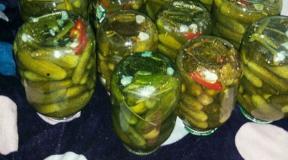Genetically modified foods. Genetically Modified Foods
A genetically modified organism, or GMO for short, is a living or plant organism whose genotype has been modified using genetic engineering methods to create new properties of the organism. Such changes today are made almost everywhere in the field of food production for economic purposes, less often for scientific purposes.
Genetic modification differs by purposeful construction of the organism’s genotype, which, unlike random, is characteristic of natural and artificial mutagenesis.
A common type of genetic change today is the introduction of transgenes to transgenic organisms.
Due to genetic modifications, cassava roots (Manihot esculenta, the euphorbia family), the main raw material for cooking for many millions of Africans, increased about 2.6 times. American genetics, having done the above modification, expect that the modified cassava (cassava) will be the solution to the problem of hunger in dozens of African countries.
Professor R. Sayr and his team - molecular biologists from the University of Ohio - seized E. coli gene, which regulates the synthesis of starch, and implanted it in three shoots of cassava.
Sair comments: cassava has almost the same gene, but its bacterial version is about 100 times more active.
As a result, the modified cassava, which was cultivated in the greenhouse, has enlarged tuberous roots (200 g, whereas in the usual cassava 75,). The number of roots (from 7 to 12) and leaves (from 90 to 125) also increased.
Both the roots and the leaves of cassava can be eaten. Cassava serves as the primary raw material for cooking in 40% of Africans, and its root is regularly consumed by about 600 million people.
However, Sair noticed that large sizes do not provide a proportionate energy value of the product. And GM plants still need to be quickly processed immediately after extraction from the ground, because the roots and leaves of not properly processed cassava possess a substance that provokes the synthesis of cyanide.
Scientists at the University of California at Auckland have received a specific film from GMO bacteria.
New Scientist writes that in the course of the research a group of scientists, Chris Voight, used E. coli (Escherichia coli), which does not need sunlight for survival. To impart the required properties to Escherichia coli, the researchers introduced the genetic material of the blue-green algae into the membrane of Escherichia coli cells. As a result, Escherichia coli began to respond to red light.
After this, a colony of bacteria with a genetically modified genome was placed on a medium with specific indicator molecules. When exposed to this "biofilm" with red light, one of the genes of Escherichia coli is deactivated, which causes a change in the color of the indicator molecules. As a result, by changing the state of microorganisms at specific locations of the film, a monochrome image can be obtained. In this case, due to the microscopic size of microorganisms, the picture has an incredible resolution - about 100,000,000 pixels per inch squared. However, it takes about 4 hours to get a square inch of the picture.
Scientists believe that their achievement will most likely not be applied in the field of ordinary photography. However, these experiments can provoke the appearance of nanofactures capable of creating any substances specifically in those areas where the light falls.
The community of American scientists has decided to patent the first in the history of artificially synthesized living organism. People are not the first time trying to replay nature, this time starting with obtaining a patent.
Researchers from the Venter Institute for many years attempted to create an artificial bacterium with the smallest possible number of genes based on the structure of the bacterium Mycoplasma genitalium, in which they registered 250-350 genes necessary for survival. The synthetic organism was supposed to be called Mycoplasma laboratorium (mycoplasma laboratory). The experiments were carried out in secret mode. In 2004, the founder of the institute, Craig Venter, claimed that an artificial microorganism would be created by the end of the year, but he was mistaken.
And today a petition has been received for obtaining a patent for both the artificial bacterium itself and its genetic code, says World Science. GMOs used to acquire patents, but now, as the scientists of the Venter Institute say, this concerns the whole artificial genome synthesized by human hands. The patent application states that the artificial microorganism possesses 382-387 genes.
An artificial microorganism was created by removing its genetic material from the bacterium, which serves as the basis, and implanting artificial genes synthesized by laboratory methods. An intractable problem is not only synthesizing genes, but also introducing them into a bacterium and regulating actions.
Michael Cybert, a researcher at the American laboratory at NREL and his colleagues at the University of Illinois, are developing a modification of algae at the molecular level to produce large quantities of hydrogen.
Before that, scientists have already demonstrated the method of producing hydrogen by taming bacteria. In addition, the interesting idea for the production of hydrogen from sunflower oil was proposed.
The researchers found that hydrogen is one of the elements involved in the photosynthesis reaction in algae. But in order to make it possible to produce it in production volumes, it is necessary to determine the hydrogenase processes and enzymes necessary for the formation of hydrogen, as well as the reaction to produce oxygen.
To decipher these chains of connections, scientists use powerful computers and are already planning how to modify the algae. After the desired modification, they will produce hydrogen 10 times faster than natural algae, says Cybert.
As the development scientists calculated, a specialized farm (or several farms) with an area of approximately 20,000 km2 could produce hydrogen for all cars in the United States, even if they were all equipped with fuel cells and not internal combustion engines.
But even if such fuel extraction does not become such a global practice, the contribution of GMO algae will still be of great benefit to the environment.
Genetically modified rice, unpretentious to insects, on Chinese farms: benefits and reflection on human health.
Until now, no state of cereal crops used in food has been grown for the most part from GMOs. But the practice in China, in which genetically modified rice is grown in ever-growing quantities, confirms that it benefits small farmers and probably benefits the people.
China is on the verge of global distribution of the cultivation and production of genetically modified rice. In China, a study of two of the 4 varieties experienced by farmers was carried out. In a word, such rice is at the final stage before permission for global use.
Randomly taken farms were developed, developing unpretentious varieties of rice to harmful insects, and on their own, without the help of professionals in this field. It was determined that, compared to farms where traditional rice was grown, small and poor farms benefited from the use of genetically modified organisms, since they collected a larger crop with a small consumption of pesticides. Reducing the amount of pesticides used is also a very positive factor in maintaining the health of the people.
Text: Karina Sembe
What is GMO
A genetically modified organism (GMO) is a plant, animal, or microorganism whose genotype has been modified using genetic engineering techniques. The Food and Agriculture Organization of the United Nations (FAO) considers the use of genetic engineering techniques to create transgenic plant varieties as an integral part of agricultural development. Direct transfer of genes responsible for useful traits is a natural stage in the development of animal and plant breeding, this technology expands our ability to control the creation of new varieties and, in particular, the transfer of useful traits between non-breeding species.
Today, the overwhelming majority of genetically modified products are soy, cotton, canola, wheat, corn, potatoes. Three-quarters of all modifications are aimed at increasing plant resistance to pesticides - means against weeds (herbicides) or insects (insecticides). Another important area is the creation of plants that are resistant to the insects themselves, as well as to the various viruses that they carry. Scientists change the shape, color and taste of crops less often, but they are actively engaged in plant breeding with an increased amount of vitamins and microelements - for example, modified corn with vitamin C content 8 times and beta carotene 169 times higher than usual.
With all the ambiguous attitude to the phenomenon in society, scientifically based evidence of the harm of GMOs to humans, plants and the environment today does not exist. More than 100 Nobel Prize winners recently signed an open letter in support of the use of genetic engineering in agriculture, in which they called Greenpeace not to oppose the use of GMOs. The use of genes of various types and their combinations in the creation of new varieties and lines is included in the FAO strategy for the preservation and use of the genetic resources of the planet in agriculture and the food industry. Anyway, part of the public is not yet ready to trust the scientific findings and believes that genetically modified products can be dangerous to health. It seems that in recent years it has become somewhat clearer which of the perceived risks are exaggeration, if not manipulation, and which actually expose the "vicissitudes of the method."
What is the use of GMOs?
for agriculture
What is genetic engineering and how thorny the institutionalization of prejudices can make its way, makes it clear one visual and fairly sensational case. In the mid-90s of the last century, Hawaiian farmers faced a serious problem: the harvest of papaya, the most important product of the region, was hit by a ring-spread virus transmitted by insects. After many vain attempts to save the fruit - from breeding to quarantine - an unexpected way was found: put the gene of the harmless component of the virus - the capsid protein - into the papaya DNA and thus make it resistant to the virus.
Because of the secondary role of papaya in the global market, the American agricultural company Monsanto, a giant in the field of genetic engineering, and two other companies licensed the technology to one of the unions of Hawaiian farmers and supplied them with free seeds. Today, genetically modified papaya is a proven triumph: a new technology has saved the industry. At the same time, the Hawaiian story is a modern parable: the virus was overwhelmed, the papaya barely survived the protest campaign and at some point was threatened with expulsion from its home state.
The US Department of Agriculture examined test crops and reported that the technology does not have "any detrimental effect on plants, non-target organisms, or the environment," and the Environmental Protection Agency noticed that people have long consumed the virus along with the common infected papaya. . According to the evidence of the organization, particles of ring blotch virus, including harmless proteins from the shell, used in gene modification, were found in fruits, leaves and stems of most unmodified plants.
These arguments did not satisfy the fighters against GMOs. In 1999, one year after farmers started producing modified seeds, critics of the method stated that the viral gene could interact with the DNA of other viruses and create even more dangerous pathogens. A year later, Greenpeace activists had already crushed papaya trees at the research base of the University of Hawaii, accusing scientists of inaccurate and random experiments that are contrary to the will of nature. Fighters against GMOs rarely take into account that a much more “random” mutation occurs in nature, and traditional selection, the precursor of genetic engineering, also produces completely “modified” organisms and to a much greater degree sins “inaccuracy.”
Genetic engineering can not only protect products from environmental exposure, but also, perhaps, strengthen our health.
Although for all the time that papaya with GMOs was on sale, it did not have time to harm anyone, during the long-term zero fruit it was not allowed to rest. Only in May 2009, as a result of several years of testing, the authoritative Commission on Food Security of Japan approved the cultivation of genetically modified papaya and two years later opened its market for it. American scientists who conducted tests under the control of Japanese colleagues, made sure that, contrary to the beliefs of the camp of opponents, the modified protein does not match the genetic sequences with one of the known allergens and that a normal infected papaya contains eight times more viral protein than the genome modified version.
Genetic engineering can not only protect products from environmental exposure, but also, perhaps, strengthen our health. Today, about 250 million preschool children around the world suffer from a deficiency of vitamin A in the body. Each year, from 250 to 500 thousand of such children completely lose their sight, and half of the blind are dying within a year. The problem is especially prevalent in Southeast Asia: the basis of the diet there is rice, and it does not cover the need for beta-carotene - a substance that, when digested, is converted to vitamin A and plays a crucial role in maintaining vision. As you know, vitamins in the form of supplements are not full-fledged substitutes for the nutrients that we get from food, and besides, in many parts of the world vitamins are simply not on sale or people cannot afford them.
A group of scientists led by Ingo Potricus from the Swiss Federal Institute of Technology set out to solve this problem by growing rice containing enough beta-carotene. Golden grains, obtained in 1999 through the introduction of genes for flowers of daffodils and bacteria, were perceived as a breakthrough in the scientific community, and scientists even received encouragement from the American President Clinton. However, Greenpeace was outraged: in their opinion, “golden rice” became a Trojan horse of genetic engineering (they even linked the risk of cancer) and did not contain enough beta-carotene to cover the need for vitamin. In the latter, eco-activists turned out to be right, but already in 2005, Potrikus and colleagues corrected and produced rice containing 20 times more beta-carotene than usual.
Despite the effectiveness of the technology, GMO opponents continued to condemn Potricus’s initiative and advised them to grow conventional carotene products instead of “artificial” rice, ignoring the particular climate and economies of a number of Asian countries that were primarily interested in the experiment. The activists became indignant when, during clinical trials in China in 2008, 24 children were given a try of golden rice. Porridge, obtained from 50 grams of cereals, covered 60 percent of the daily children's need for vitamin A, and the content of beta-carotene was equal to the capsule with provitamin, which was received by the second group of subjects, or small carrots.
Why marking "non-GMO" is not a guarantee of security
Concern about some aspects of genetic engineering in agriculture, for example, the linkage of GMOs using herbicides or obtaining patents, has a basis. But none of the really important issues concerns the scientific aspect of genetic engineering, and the more so the moral component of this practice. Genetic engineering is a technology that can be used in various ways, and for a clear statement of the question, it is important to understand the difference between the goals of the method and study each particular case in detail. If you are worried about pesticides and transparency in matters of origin of products, you need to know about the composition and quantity of toxins that your food is exposed to. Of course, the mark “non-GMO” does not mean that the farm has done without pesticides, and information on the content of GMOs, on the contrary, will not make it clear why genetic manipulations were carried out - possibly to save crops from the virus or to enhance nutritional properties. In fact, choosing products without GMOs, we never know whether we are making the right choice, because a genetically modified alternative might be safer.
While GMOs are attacking from all sides, the biopesticide industry is booming. When buying “non-GMO” products, it seems to us that we get healthy food without toxins, while in fact, we may consume more harmful substances. It turns out that the marks on the content of GMOs do not make it clear what we actually eat, but only provide the illusion of safety.
What are the consequences still worth thinking about
Over the past twenty years, hundreds of studies have been conducted and tons of genetically modified foods have been eaten. Among them are not only plants, but also, for example, fish: salmon modified to accelerate growth, or carp resistant to the bacteria Aeromonas. No amount of research will be enough to convince skeptics of the safety of GMOs. In turn, consumers can only rely on common sense and rely on the impartiality of numerous scientists whose studies speak in defense of genetic engineering.
However, the safety of GMOs for the human body is not the only cause for concern. One more problem needs to be looked for in one of the most widespread spheres of the use of genetic engineering - in the production of crops tolerant to herbicides. In the United States, where this technology is common, three quarters of cultivated cotton and corn are genetically modified to resist insects, and up to 85% of these plants are modified to form resistance to herbicides, in particular glyphosate. By the way, one of the leaders in sales of glyphosate is the aforementioned company Monsanto, which specializes in genetic engineering.
While GMOs that are resistant to insects, lead to the use of fewer insecticides, engineering-modified plants tolerant to herbicides, entail an even more active use of these substances. The logic of farmers is as follows: since glyphosate does not kill crops, it means that you can spray herbicides as generously as possible. As the “dose” increases, the weeds also gradually develop tolerance to pesticides, and more and more substance is required. Despite the debate around the safety of glyphosate, most experts claim it is relatively safe. But there is an important indirect connection: tolerance of weeds to glyphosate forces farmers to use other, more toxic herbicides.
What to expect in the near future
The more you learn about GMOs, the more complex the overall picture seems. First comes the realization that genetic engineering is not at all evil, but then you realize that using GMOs can have far from happy consequences. Pesticide against pesticide, technology versus technology, risk versus risk — everything is relative, therefore in each particular case it is important to sensibly evaluate possible alternatives, choose the lesser of evils and not blindly trust the labeling “without GMOs”.
About genetically modified products knows every hostess. True a little. We are sure that if we make an experiment and offer to try a dish made from genetically modified products and grown in natural conditions without the intervention of genetic engineering, then you will not even feel the difference. Marketers have long used “non-GMO” labels on bright product labels, and we intuitively choose packaging with this label, believing that this is indeed a more useful product. Although a few of us will be able to clearly answer what is genetically modified foods and why they are so dangerous. Fashiontimedecided to conduct an educational program on this controversial issue and find out about the benefits and harms of GMOs.
What is GMO?
Genetically modified organisms (GMOs) are food and organisms in which genes are transplanted from other plant or animal species. Every year, the population of our planet is increasing, and it needs more and more food. The soil and fertile lands in which they grew crops are depleted. In order for the plant to get additional properties, such as resistance to diseases, increasing resistance to insects, as well as increased yields, the gene of another plant is transplanted into its cells. This whole procedure takes place in the laboratory. For example, if it is necessary to harvest ripe and tasty strawberries in winter, the gene of the Arctic fish will be introduced into its cage. This will in no way affect the taste, but is aimed at identifying cold resistance in the strawberry fruit. However, if you are allergic to fish, it can be manifested by eating these GM berries.
The use of GMOs for food production has recently been allowed in Russia. Only 14 species were included in the list of allowed GM foods: 8 varieties of corn, 4 varieties of potatoes, 1 grade of rice and 1 grade of sugar beet. In our country it is forbidden to use GM foods in the production of baby food. Nevertheless, from abroad on the shelves of our stores gets a lot of products with GMO content. According to the National Association for Genetic Safety, about 30–40% of the foods in our diet contain GMOs. In the US, the level of genetically modified products is about 70%. Therefore, most products imported to Russia from the United States are genetically modified.
Today in the world there are over 60 species of plants grown with the help of genetic engineering. The list of transgenes includes the most popular foods that we consume daily: rice, corn, soybeans, eggplants, apples, wheat, cabbage, strawberries, cucumbers, tobacco, and others.
The benefits of genetically modified products
The emergence of genetically modified products in the first place had a beneficial effect on agriculture. Growing genetically modified vegetables and fruits can increase the yield by several times. And since these products are easier to grow, their cost is much lower. GM products are also able to independently fight against insects, weeds, and resist viruses and bacteria.
Scientists in the laboratory can remove GM foods with a high content of vitamins and nutrients. Genetically modified products are also used in pharmacology, producing vaccines against various diseases based on them.
The debate about the benefits and harms of genetically modified products did not subside with the breeding of the first GMO. There are no clinically confirmed studies that would prove that the consumption of GMOs bears direct or indirect harm to human health. On the contrary, the removal of genetically modified products over time will increase the level of human immunity.
Harm of genetically modified foods
The science of breeding genetically modified products is quite young. The first transgenic products were developed by Monsanto in 1988. So far, there is no established opinion on how harmful GM foods are. But environmentalists, scientists, and even religious organizations are against the introduction of GM foods. Many scientists believe that GMOs increase the risk of dangerous allergic reactions, food poisoning and even mutations. They also contribute to the development of antibiotic resistance.
The green movement has its own concerns about this. Environmentalists believe that a genetically modified plant adversely affects the environment. For example, transgenic corn destroys not only harmful insects that are detrimental to yield, but also others that are completely harmless. Another serious problem is the crossing of cultures of one subspecies, during which one plant (weed) receives the genes of a healthy and edible product. As a result, the weed acquires the beneficial properties of its fellow and becomes completely immune to herbicides.
Many scientists argue that genetically modified products harm the human food system, disrupting the metabolism and intestinal microflora, causing a weakening of the immune system and the development of cancer.
Where is GMO?
Most often GM products are found in imported products. Transgenic products are grown in most countries of the world: USA, Brazil, Canada, China, Argentina, South Africa, Pakistan, India and with small numbers in almost all EU countries. Genetically modified plants can be part of meat and sausage products, confectionery and bakery products, baby food, dairy products and margarine, vegetable, peanut butter, mayonnaise and other sauces.
The manufacturer is obliged to inform on the packaging of the goods if the product contains more than 0.9% GMO. The corresponding changes to the law of the Russian Federation “On Consumer Rights Protection” were made on December 12, 2007 The presence of transgenic products and its percentage should be indicated on the label in the list of ingredients.
There is a famous list Greenpeacewhich lists companies that produce GM products. Many of them you probably know. We chose the most popular brands on the Russian market: Nestle, Unilever, Hershey's, Coca-Cola, McDonald's , soups Campbell, Knorr.
Choosing products in the supermarket, we usually pay attention to the composition. On many of them, you can see the mark “Without GMOs”, indicating that genetically modified engineering did not have a hand in growing this product, and, therefore, it can be considered clean and safe. But if you think about what we know about genetic engineering and should we be afraid to include GMO products in our diet? Let's figure it out.
What is GMO
First of all, let's deal with the concept of GMOs. A genetically modified organism is an organism whose gene has been altered by crossing with the gene of another organism. For modern scientists, such crossing does not pose any problems, they easily connect the gene of the plant, with the genome of a bacterium or even an animal.
Why do you need to ask? In fact, genetics have made a revolutionary discovery, learning to overcome interspecies barriers and connect the genes of various organisms. Due to this, it is possible to improve the properties and characteristics of a particular organism. It looks like this. A GMO potato is a potato in which a poisonous insect gene is implanted, as a result of which this product is bypassed. As a result, we get beautiful tubers without damage and wormholes. Or tomatoes with GMOs are tomatoes with which the gene of the northern flounder is implanted. As a result of such a crossing, tomatoes are not afraid of the cold and do not turn black after heavy fogs. Vitamins that were previously not contained in wheat are implanted in wheat today, and human albumin is in grains in rice. This is done to increase the benefits and enhance the nutritional properties of cereal crops.
Among other things, it turned out that genetic engineering had a significant impact on crop yields, because with the implantation of alien genes, the products became more durable and resistant to temperatures. All this significantly reduced the cost of harvesting and increased the profits of farms. Is it any wonder that farmers grow genetically modified products with pleasure? Yes, and consumers are much nicer to buy juicy bulk apples, peppers or tomatoes that look great, have an unsurpassed taste, and at the same time have absolutely no damage. Only one fact is disturbing, which cannot be ignored.
What are dangerous products with GMOs?
Humanity is concerned with genetically modified products, primarily because such products contain an alien gene. There is an objective fear that modified products are harmful to humans, just as long as their harm is not so obvious, but in the future, perhaps even after several generations, products with GMOs will cause a crushing blow to our descendants. In addition, there are suspicions that genetically modified foods can cause allergies, cause the growth of malignant tumors, disrupt metabolic processes in the body and resistance to antibiotics.
Oil is added to the fire and the statistics indicate that in the United States, where the vast majority of products contain GMOs, more than 75% of the population suffers from allergies. At the same time, in Sweden, where a ban has been imposed on the use of these products, the number of allergy sufferers does not exceed 5%. It is possible that the presence of allergy is in no way connected with genetic engineering, but such data is very alarming and forced to look with caution at all products of this kind.
At the same time, genetic scientists assure us that there is no threat from the use of products with GMOs, since in the process of digestion their gene cannot cross with the human gene. True, the evidence provided by scientists does not exclude the risk of gastrointestinal diseases, allergic pathologies or cancers caused by the activities of transgenes in the human body.
The opinion that products with GMOs are no more dangerous than products with preservatives and flavors may have a right to life, but this does not mean that you should turn a blind eye to such harm. Be that as it may, modern science has no evidence of the safety of genetically modified products, and therefore the term “potentially dangerous product” is used in relation to them.
Why create products with GMOs
Many have a question, why were products created, the effect on the body of which is impossible to control? Here you need to look into the story. It turns out that the first transgenic products were born in the USA in the mid 80s of the last century, and they were created with the good goal - finally, to save humanity from hunger and feed the third world countries. That's just the reality turned out the opposite. Almost all African countries have abandoned the use of products with GMOs, restrictions have been imposed on them in European countries, but in the USA these products are produced everywhere and are very popular. And what about us in Russia?
Products with GMOs in Russia
The number of genetically modified products in countries is monitored by the well-known organization Greenpeace. According to their data, more than 35% of products in our country contain an altered gene. And every year the number of such products increases. Why it happens?
At once, we say that the import of transgenic products into the Russian Federation is not prohibited, and therefore on the shelves of our stores natural products are side by side with products touched by genetic engineers. Moreover, while in European countries it is not difficult to distinguish genetically modified products from natural ones due to a lower price, in Russia, natural vegetables and vegetables with a gene mutation cost about the same.
Many are unlikely to be pleased with the fact that, since July 2014, the cultivation of cultivated plants by the GMO method has been allowed in the Russian Federation. Moreover, permission was given to cultivate 14 species of plants, among which: corn - 8 varieties, potatoes - 4 varieties, sugar beet - 1 variety and rice - 1 variety.
Our scientists have already responded to this permission, saying that the cultivation of modified cultivated plants will lead, no less, to the complete destruction of agriculture in the country! According to experts, the cultivation of GMOs on the territory of our country will lead to the emergence of super-pests, which already appear in other countries. But what is even more dangerous, the harvest of farmers who grow organic produce will be polluted, as soil contamination occurs under the influence of transgenes. And here you do not need to look for evidence. Just look at the soils of those countries where modified vegetables and fruits have been grown for a long time. For example, all rapeseed in Canada today has become genetically modified, and all because of the fact that the pollen from the grass with the altered gene has spread to surrounding fields.
Many are reassured by the fact that GMO products in the USA are sold without restrictions and are not considered potentially dangerous. However, those of us who adhere to a healthy diet should know foods that may contain a modified gene.
Products that may contain GMOs
1. All products containing soybean, corn and canola
According to unofficial sources, all these products found on the shelves of supermarkets contain GMOs. Having noticed the inscription “plant protein” on the product label, do not hesitate, this is 100% transgenic soy. By the way, this protein is found in most meat and sausage products, in mayonnaise and ketchup, chips and canned food, as well as in soy milk products.
2. Margarine and vegetable oil
According to statistics, 90% of all vegetable oils in our stores contain GMOs. Moreover, some manufacturers even dilute olive oil with soybean, and do not even report it on the labels.
3. Candy, chocolate and ice cream
Almost all chocolate products contain genetically modified ingredients. You can notice this in composition, in which there is soy lecithin. Similar soy components are also found in ice cream, as, indeed, in all other dairy products.
4. Baby food
The vast majority of foreign and domestic producers use for the production of baby food dairy products and cereals with GMOs.
5. Confectionery and bakery products
Flour as well as bakery and confectionery products may also contain altered genes. According to statistics, in our country more than 25% of all flour products contain these potentially hazardous substances.
6. Vegetables
Some vegetables are also subject to genetic change. GMOs are most commonly found in potatoes and tomatoes, beets and zucchini, melons and papayas.
How to distinguish transgenic products
We have already mentioned that the cost of modified and natural products in our country is equal, which means it will definitely not be possible to identify potentially dangerous products at a cost. The appearance will also say little to the average man, although in the early spring, purchasing large, juicy peppers, cucumbers or tomatoes, one can hardly expect that they are grown exclusively by natural means.
You will be surprised, but you shouldn’t count on the “no GMO” inscription on the labels of some products. It turns out that, according to our legislation, the “No GMO” badge is placed on products containing less than 0.9% of substances with an altered gene, however, many manufacturers bypass this restriction.
Another thing is the composition of the product. Having noticed soybean lecithin or E322 as a component of soft drinks, cereal or baby food, you can be sure that this product has a crossed gene. The same can be said in the presence of maltodextrin, aspartame, dextrose, glucose, vegetable fat and soybean oil. And be sure to look at the country of origin. Remember, almost 70% of all GMO products are produced by the USA, and Canada and France are next on this list.
What remains to do simple buyers? Environmentally friendly products exist, they just need to look for.

Scheme 1
Natural products coming to us from Europe are labeled Organic or BIO, with this badge (Figure 1).

Scheme 2
You can, for example, find such flour or oat-flakes (Scheme 2).

In addition, natural products from Europe can be labeled with other icons (Figure 3).


Scheme 4
By purchasing products with such a label, at 99% you can be sure that this product has done its entire journey from agricultural land to processing plants and packaging in strict compliance with environmental standards and has not been subjected to gene change. In our country, the most high-quality products have the Rostet badge (Scheme 4).
By purchasing products with such a designation, of course, you will not protect yourself from GMOs, but you will be sure that it has passed strict quality control. In addition, try to purchase products from those farms, the quality and naturalness of which you are sure. In extreme cases, buy the appropriate vegetables and fruits in the season, while there is such an opportunity, because crops sold in winter and early spring, as a rule, have a crossed gene.
Trends in recent years suggest that the number of genetically modified products in the world will only increase. However, this does not mean at all that we should take the lead from manufacturers and use products that we are not sure about. Look for organic vegetables and fruits or grow them yourself, they are the ones that bring us health and benefits!
Take care of yourself!
In the 90s, a new kind of seemingly familiar food appeared - GMO. Since then, now a quarter of a century, the greatest scientists on the planet have been debating about the benefits and dangers of GMO food. The article will help to understand whether genetically modified products are so harmful.
In the previous article we reviewed and described their differences and composition. Today we are talking about such a common misconception as harm GMOs.
GMOs - harm or benefit
On the shelves appeared surprisingly attractive fruits, vegetables, meat, fish, with a uniform color. Groats are also pleased with their selections. And it cost several times less than the usual food, with a bunch of external flaws. The taste of GMOs differed in fresh woods, but few people were worried about saving on inexpensive products.On the safety of genetically modified organisms for human health, the conclusion of the EC Director General for Science and Information, made on the basis of 1500 world studies by the institutes of engineering genetics science, is noted.
According to manufacturers, experiments, a thorough study of genetic biologists, the appearance of genetically modified nutrients contributes to:
1. Increasing the resistance of plants to bacterial action, fungus, and other diseases.2. Reduce the potential danger of invasion of rodents and insects, as the plants become unattractive for them.3. The volume of agricultural products is increasing, as it is adapted to drought seasons, sudden frosts.4. Nutrients, vitamins, minerals are introduced into the chain.5. Replenish the market of forage crops.6. Increasing the availability of products for low-income people.7. Strengthening the quality of food of animal origin - meat, milk, eggs.8. Reduce air pollution, as there is no use of toxic chemicals.
 GMO Research
GMO Research
About the dangerous effects of GMOs, according to the works of biologists - Irina Ermakova, Arpada Void, Jacques-Eric Séralini. These studies were thoroughly checked, refuted, and the scientists criticized. An interesting fact is that the fighters who defended the gene modifications worked in the laboratories of the largest gene developers. Among them, the progenitor of plant genetic engineering is Monsanto. In 2010, the OAGB, together with the Severtsov Research Institute, conducted complex experiments with mammals. Revealed the hardest side effects after the consumption of biologically modified species - reproduction of malignant cells, an increase in organs, infertility.
January 30, 2015 to the scientists listened. In Russia, a bill has been passed, as a result of which, genetically modified crops are permissible for planting exclusively on experimental sites.
Products containing GMOs, plant seeds and food of animal origin are carefully monitored and regulated by law. Each of them, before entering the markets of the country, is initially thoroughly tested on high-tech devices of genetic engineering. Harm to organisms of animals, people, environment is checked. If the product is deemed acceptable for consumption, manufacturers are allowed to sell.
Should we be afraid of nutrient nutrition
There is no unequivocal opinion about the benefits or harm of biogenic development. Nevertheless, it is necessary to take into account that genetics is a complex structure, the introduction into which may attract negative consequences. It is impossible to take into account the reaction of each organism - intolerance, allergies. A person acquiring transgenes does not know which microorganisms he will use.
The risk of genetically modified elements is divided into conditionally potential and proven.
Proven:
The emergence of adapted pathogens - insects, weeds.The disappearance of natural biological samples due to pollination with transgene.caused by a lack of nutrient balance.Intolerance and allergies.
Conditionally potential:
The toxicity of products associated with the lack of research on the cessation or development of mutational properties after ingestion.Possible development of malignant tumors.Immunity to use antibiotics.
List of GMO Products
Domestic companies, after the law on the restriction of sowing, buy foreign raw materials. Well-known Russian companies using GM are Daria-ready-to-cook foods, Talosto, Klinsky meat processing plant, KampoMos, Bogatyr, Galina Blanca, Yubileinoye cookies.Common Products often undergoing genetic modification:
Soybean, sunflower, corn;
Potatoes;
Cereal products (white flour);
Tomatoes;
Fruits;
Multicomponent formulations products containing GMOs:
Chocolate;
Carbonated drinks;
Fish, meat - semi-finished products from them;
Margarine;
Milk products;
Wine and vodka products;
Baby food (dry mixes, mashed potatoes, juices).
In Russia, they sell products that are exceptionally harmless and do not pose a danger to humans. But so far there are no exact mechanisms for determining the safety of a product.
How to determine the content of nutrients
The definition of GMOs in products is regulated by law. Even if the components have one harmless element, manufacturers undertake to indicate the content of GM in the composition and on the special labeling of products.Visually determine the content of genetically modified organisms is also possible. This is a suspiciously cheap product. There are no flaws in GM, it has been stored for weeks without a refrigerator. When cut, fruits and vegetables, give a small amount of juice. They taste fresh, lean.
Meat, fish also with a pronounced, unnatural color. When cutting, it is easy to separate with neat slices.
Do not pay attention to the bright words "Does not contain GMOs". The legal right of the manufacturer is to write on the cover, whatever. Look at the composition. There, companies, according to the law, indicate only reliable information.
Eating or not using GMOs in food is everyone’s personal choice. Of course, one should not rush into and suspect every product in its biogenicity. It is important to remember that only at the slightest signs of strange diseases, it is necessary to review the food menu and seek help from a doctor.






















